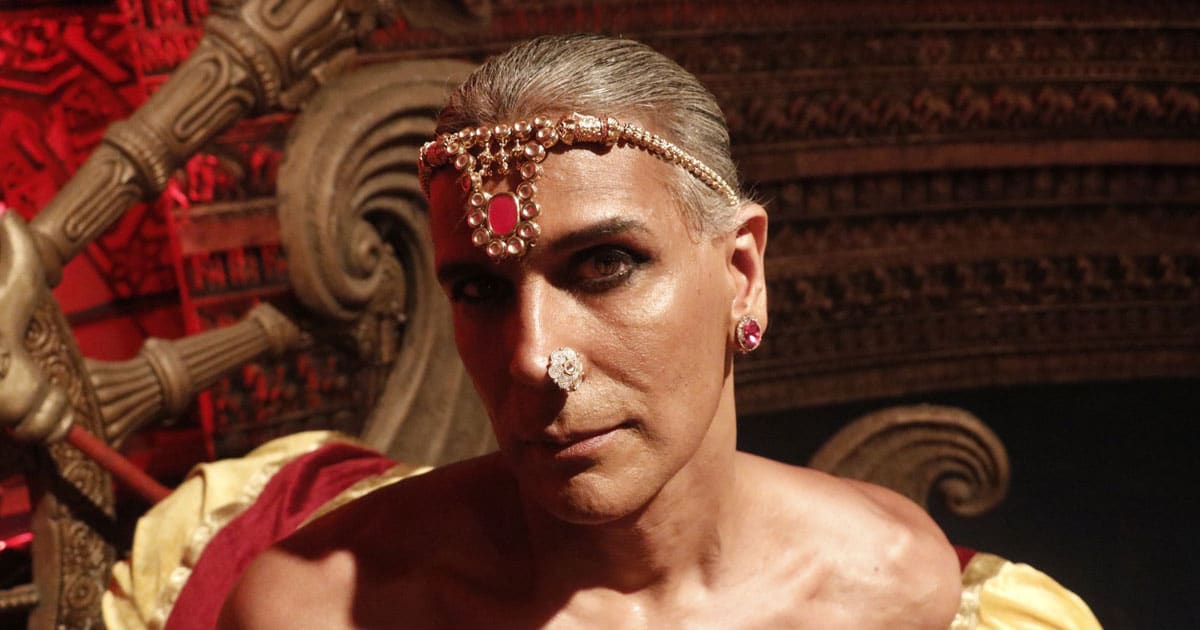Milind Soman is all set to woo us by playing the third gender in ALT Balaji’s upcoming web series Paurashpur. Soman has a history of choosing off-beat subjects in his work and this time he is shedding his all masculine image to play the transgender.
Paurashpur is a fictional historic kingdom, which riddles with politics and gender wars, and Milind’s character plays a pivotal role in representing the transgender community. Unlike the stereotypical Bollywood trans characters, Milind plays a quick-witted Boris who is the embodiment of the third gender in ancient India who back then were actually revered.

Bollywood’s representation of the transgender community has always been problematic. We rarely do get to see a trans character played by an actual trans person. But more importantly, there are only two kinds of roles that Bollywood sees trans characters fit for – either an over-stereotyped character who is the butt of all jokes, or an evil criminal who unapologetically carries out heinous crimes.
Did you read this story?
Meet India’s First Transgender OT Technician – A Sanskrit Graduate Who Begged At Railway Stations
But Paurashpur’s trailer seems to give us a ray of hope for a more natural representation.
Yet gender incongruence for long was regarded as a psychological disorder. Internationally, the classification was used to refute the identities and health needs of persons who belong to a different gender than the one they have been ascribed by society or at birth.
Ironically ancient India was much more inclusive than the country we live in today.
In epics like Ramayana and Mahabharata, we come across numerous instances of “the third gender” holding a significant part of the story. This shows how they have not only been considered a normal part of ancient and medieval society but have also held an essential place in the epics, which are considered to be holy by a large portion of the Indian population. For example, Shikhandi, a transgender person who was a woman reborn as a man, was considered the key to defeating the Kaurava army in Mahabharata and held a special place in Krishna’s eyes.
The language of the gods itself, Sanskrit, that was used to write all major Hindu epics, uses three genders: masculine, feminine, and gender-neutral.
In other epics such as Shiv Puran, Lord Shiva manifests himself in a form called Ardhnarishivara—half man and half woman—which is worshipped all around India. Ardhnarishvara, as a figure, proves that fluid genders and sexualities have been an integral part of our country.
Even the architecture (Khajuraho, Konark Sun Temple) of ancient India speaks for gender and sexual orientation inclusion.
Besides Hindus, the Mughal Empire provided special status to the transgender community. The Dutch merchant Francisco Pelsaert, during his visit to the Mughal court in the seventeenth century, made a surprising discovery, which is that of the prestige and power enjoyed by the third gender, or eunuchs in the imperial household.
“They can get whatever they desire- fine horses to ride, servants to attend them outside, and female slaves inside the house, clothes as fine and smart as those of their master himself,” he wrote in his travelogue.
The elevated stature of eunuchs during the Mughal empire has been documented for years by foreign travelers and historians. “Even the stigmatized community of hijras in India today seem to carry something of the special powers, the baraka, of the eunuchs of earlier times, and they invoke Mughal eunuchs as their ancestors,” cites historian Ruby Lal in her article ‘Harem and eunuchs: Liminality and networks of Mughal authority’.
How India came to despise the transgenders
India’s despise for the third gender is rather recent and can be rooted back to the British Rule. British officials often considered eunuchs “ungovernable”. Commentators at that time said they evoked images of “filth, disease, contagion, and contamination”. They were pictured as people who were “addicted to sex with men”. Colonial officials quoted they were not only a danger to “public morals”, but also a “threat to colonial political authority”.
In the 19th century, the Indian provinces launched a campaign to reduce the number of eunuchs with the objective of gradually causing their “extinction”. They were considered a “criminal tribe” under a controversial 1871 law that targeted caste groups that were considered to be hereditary criminals.
The law further armed the police with the power of increased surveillance of the community. They compiled registers of eunuchs with their personal details, often defining “a eunuch as a criminal and sexually deviant person”. “Registration was a means of surveillance and also a way to ensure that castration was stamped out and the hijra population was not reproduced,” writes Dr. Hinchy, assistant professor of history at Singapore’s Nanyang Technological University in his study.
They were even prohibited from appearing at public functions and were forced into starvation. The community reacted by petitioning for their right to dance and play in public and perform at fairs that were later made legal later on.
As a result, in a bid to survive, they became skillful at law-breaking, evading the police, and keeping on the move, Dr. Hinchy writes. They also became adept at hiding property, so the police were unable to register it.
Thus they started to be defined as deviant and disorderly. Nonetheless, they continued to make a living by dancing at weddings and other ceremonies. Theirs is indeed a stirring story of resilience and survival.
With the provision for legal status for Transgender in India attained since 2014 following the Supreme Court’s historic decision, the community has been receiving an immense amount of support over the years. Be it politics, science, or literature, the third gender is nailing every field with the newly gained upliftment.
Nonetheless, the trans community has always been extremely blessed in terms of physique and talent.

